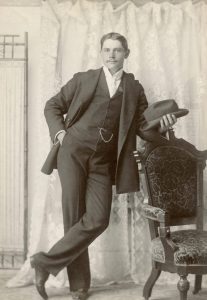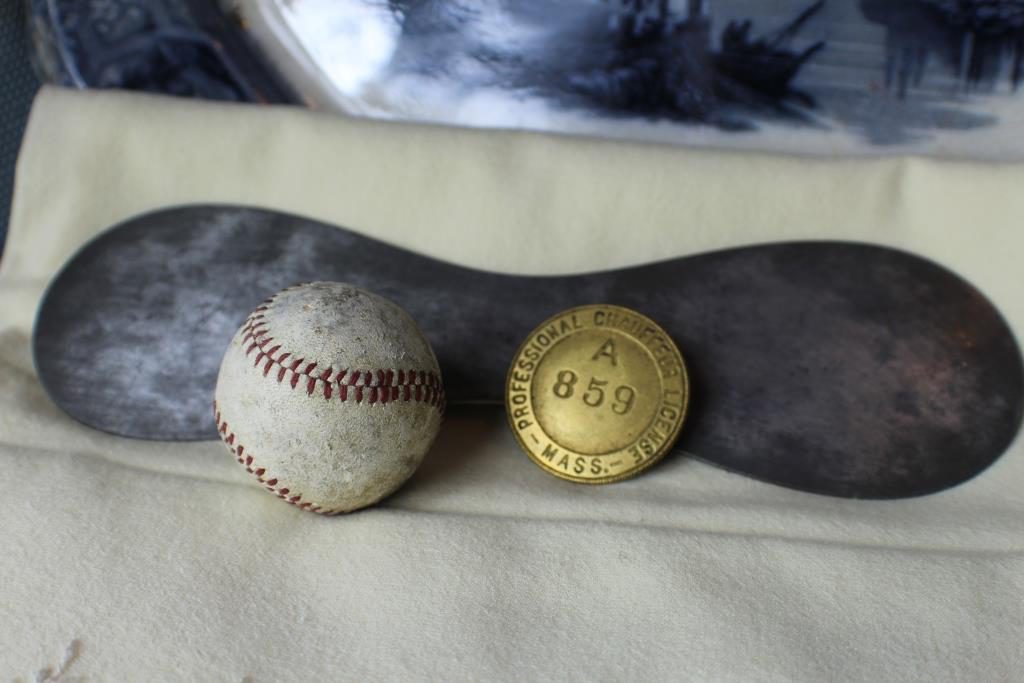 Some photographs of our ancestors are beyond price. This one of my mother’s father, Ed Hawes, was taken in 1899, when he was still planning on a Naval career. Unfortunately, as a midshipman, he was thrown down a hatch in a hazing incident that shattered his hip.
Some photographs of our ancestors are beyond price. This one of my mother’s father, Ed Hawes, was taken in 1899, when he was still planning on a Naval career. Unfortunately, as a midshipman, he was thrown down a hatch in a hazing incident that shattered his hip.
Ed, the son of a street railway motorman and mechanic, had inherited his father’s skills with tools, so with the Navy out of the picture, he started working in a bicycle store – the same store, the story goes, as Peter Fuller (son of Massachusetts Governor Alvan Fuller and later a millionaire Cadillac dealer). As a young man at the turn of the twentieth century who knew how to drive an automobile, Ed was hired as chauffeur by Harrison Harwood, owner of the H. Harwood and Sons Baseball Factory in Ed’s home town of Natick, Massachusetts.
 Harwood’s factory was the first in America to mass produce the two-piece, figure-eight stitched baseball cover.[1] They were in business from 1858 to 1978. Ed’s skills at tool making got him into the factory, and fifty years later he retired as factory manager. In the 1950s Ed was courted by the Japanese to manage a factory in Japan, but he decided against starting a new venture in his 70s.
Harwood’s factory was the first in America to mass produce the two-piece, figure-eight stitched baseball cover.[1] They were in business from 1858 to 1978. Ed’s skills at tool making got him into the factory, and fifty years later he retired as factory manager. In the 1950s Ed was courted by the Japanese to manage a factory in Japan, but he decided against starting a new venture in his 70s.
In the early years, baseballs were sewn by women at home in a cottage industry. As a child, my mother would sometimes “help” the ladies at the factory packaging the balls, so one might think that having been raised in such an environment would have given her an appreciation for the game of baseball. When my future dad was dating the baseball factory manager’s daughter, he thought it would be a good idea to take her to a Red Sox game. Mom enthusiastically cheered for every ball that was hit into the stands, fair or foul, by either team, because that meant they would have to buy more balls!
Ed had a cheerful, friendly, yet authoritative personality that was liked and respected by all. During the Second World War, in his 60s, he joined the Coast Guard and served as an air raid warden patrolling the neighborhood for visible lights at night.[2] He served the town as a constable, was a Master member of the Masonic Lodge, and knew and was known by everyone in town.
Imagine what might have been if the Navy career had worked out.
Notes
[1] The second photograph shows a metal figure-eight pattern for cutting ball leather with a salesman’s sample of the stitched ball, and Ed’s Professional Chauffeur’s badge.
[2] He lost his only son during the war; see Three Argonauts.
How wonderful that you know everything about your grandfather’s life. I wish I knew more about mine. Unfortunately, all the elders have passed and my cousins and I are the older generation.
Hilda, I am the rather overwhelmed inheritor of every genealogical photo, knickknack, memory, etc. of my mother’s entire family!
Wonderful insight to the two generations previous to your own. And so interesting to all of us:) Thank You for sharing.
Mary, thank you.
You start out with “Some photographs of our ancestors are beyond price.” Where do you decide not to purchase a picture? I recently found a picture of my grandmother playing tennis with Helen Wills, winner in many tournaments. The knowing of the fact is more important than the picture. But should I purchase the picture; the ‘snipped’ picture is not clear?
Dear Howland. Yes. Yes, you should buy the photo. Unless the price is prohibitive, it’s worth buying to have and to examine it. And though I say this as an avid collector of photographs, I began my collection by looking for family images — the few that were available online. All best, Scott
Loved this.
Thank you.
Wonderful family history here Alicia – great post!
Thanks Jeff.
Alicia, I always enjoy your informative and entertaining writing. This one, especially so, and with some close-family poignancy thrown in, too. Many thanks, once again!
I just recently ran across your post. If you ever feel like selling or parting with any Harwood artifacts… I would love to add them to my collection! You can reach me at http://www.harwoodbaseball.com
I’ve been researching the home where I live in Natick, and found your grandfather lived in my house at 71 Washington St., Natick, while searching the newly available old Natick newspapers at the Morse Institute Library website. Once I found his name (and that of his sons, wife, sister in law, etc) and that he worked for Harwood and Sons, I searched his name with the company name and found your post here. This is so interesting to learn about someone who lived in our home. If you see this, I wonder if you know when they lived at our location, or if the house was built for them? We know it was built some time between 1907 and 1915 because it was not on a map of Natick in 19078 but is there in 1915 (maps at the Natick Historical Society). Thanks for this great look into your grandfather’s life!
Courtney, This is absolutely fabulous and very timely. I am in the process of writing a blog just about the house. The house was built in 1911 and I know all the answers to your questions. Would you e-mail me at acwcrane@aol.com? I have digitized photos, etc., etc.
Hi, I sent you a link for google docs to see photos of the house currently. Let me know if you do not receive the email or link.
thanks!
Thanks, I emailed you, let me know if you do not receive it! I look forward to making contact.